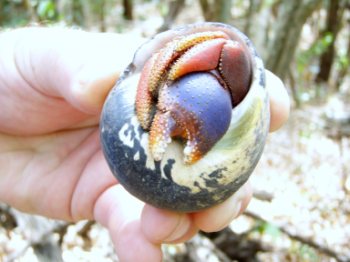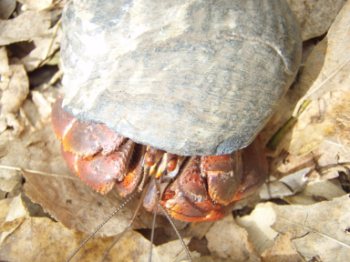|
The Caribbean Hermit Crab
The Caribbean hermit crab (Coenobita clypeatus), also known as
the tree crab, the tree-climbing crab, the soldier
crab , and the purple pincher, is a species of land hermit
crab which lives by the Caribbean
Sea, southern Florida, Venezuela, and the Bermuda Islands. This species is commonly sold in the United States as
a pet. The last of its common names is due to the distinctive purple claw. In
captivity they can live to be over thirty years old and over forty years in
exceptional cases. Caribbean hermit crabs are omnivorous scavengers who live in
colonies of a hundred or more in inland areas. As pets they prefer a relative
humidity level between 70% and 78%, and a temperature of 24 degrees centigrade
or 75 degrees Fahrenheit. Caribbean Hermit Crabs, like some other
species of crabs, are nocturnal, so how made up was I when I saw
one sitting on a tree stump during our exploration of Fort
Shirley.
  
The tree lined path where I made my find.
Bear had stopped as he had seen a large Zandoli so I have to give credit where
it is due. Bear was staring at the floor, I was looking a few feet ahead and
there was my chap
Physical description. Coenobita clypeatus is a member of
the phylum Arthropoda and the class Malacostraca. The colour varies from a pale
red to a dark brown or burgundy. The eyestalks are round and white, with a black
or brown stripe on the bottom. The eyes are oval in shape. The abdomen is short
and fat. There are four walking legs, four tiny legs to hold the shell in place,
a small pincher, a large purple pincher, and four antennae. Although these
hermit crabs live on land, they have gills, rather than lungs. The high relative
humidity of their native environments, plus water carried in the shell, allows
their modified gills to remain wet and thus to function properly in extracting
oxygen from the air.
Spermiogenesis. The testes of the species
Coenobita clypeatus contains germinal and non-germinative cells. The latter
function in the manner of the vertebrate Sertoli cells in apparently providing
nourishment, support and possibly hormones during spermiogenesis. Each Sertoli
cell surrounds several germinal cells. The mitochondria, rough and smooth
endoplastic reticulum and Goldi apparatus show changes in structure when in contact with
germinal cells in different stages of spermiogenesis. These changes are
suggestive of active synthesis and metabolism of cellular
products.

 
Bear held him up so I could get a
shot of his curled up self, I really think he needs to find a bigger shell as
way too much is "hanging out". He promptly held a
stick for Bear who then put him on the ground
for me to video him when he decided danger had past.
Diet. Caribbean hermit crabs are both herbivorous and
scavengers. In the wild, land hermit crabs feed off of coconut trees, leftovers
from humans, and scavenge dead organisms, such as fish and other crabs. Hermit
crabs are able to bury their food in the sand to consume later, but other crabs
may find it and consume it themselves. In captivity, land hermit crabs are fed
commercial foods which come in many varieties. Hermit crabs are also fed treats
that include fruits and vegetables such as coconuts, mangos, papayas, apples,
bananas, carrots, or spinach.
Shell usage and shell fights. The land hermit
crab uses a shell to protect its delicate body. The shell is sometimes that of a
land snail when it is young, but is usually that of a marine snail. When a
marine snail dies, the soft parts decompose or are eaten and the empty shell
often washes up onto the shore. The hermit crab can then find and occupy the
shell. Larger shells are necessary as the crab grows, but that growth is quite
slow. Hermit crabs are very particular about their shells. Shell switching is
not uncommon as the crab searches for the perfect shell. A desired
characteristic of a shell is an opening about the size of the large claw, plus
about 2½–3 mm (1/10 in to 1/8 in) all around (more for larger crabs). When
threatened, the crab withdraws into the shell and blocks the entrance with the
large claw. Fierce shell fights can occur when the shell supply is not adequate.
The loser often dies, since many hermit crabs will not release their grip on
their shell until they are torn apart. The loss of limbs in shell fights is
common, but may not result in death especially since the hermit crab can choose
to drop (autotomize) a limb to disengage from the conflict.

 
As soon as he confidant enough, his legs
relaxed, then his eyes came out and lastly his antennae.

 
Off he went in his shuffling gait.
Then as we were looking at a snake this tiny chap
about half an inch long, ran up to us, he was way too quick to get him in
action.
Shells used by Coenobita clypeatus.
When choice of shells is available, hermit crabs seems to prefer
intact undamaged shells with circular or oval openings and a smooth
mother-of-pearl interior. However in a pinch, they will use whatever they can
find that they can fit into, even discarded, man-made items such as plastic
glasses, broken bottles or tiny one-person jam jars. Painted shells should not
be used for a pet Coenobita clypeatus because it is a potentially dangerous
practice that may shorten the crab's life span. The paint will eventually chip
off the shell, and the hermit crab may eat the chippings. Some of the snail
shells with circular/oval openings available for their use in the wild on the
coasts of the tropical Western Atlantic Ocean include : Turban, West Indian
Topshell, West Indian Topsnail, (Over fishing of this snail (Bermuda) has been
known to negatively effect the Caribbean hermit crab population.) Periwinkle,
Tulip, Nutmeg, Rugosa, Tun, Crown Conch and Haitian Tree Snail
shells.
Growth and moulting. The Caribbean hermit crab, like all
species of hermit crabs, grows through a strenuous and hazardous process called
moulting where the exoskeleton of the animal is shed and a new, soft exoskeleton
is exposed from beneath. A moult also allows the crab to regrow lost appendages.
The smallest Caribbean hermit crabs will moult many times per year, while the
largest (about the size of a baseball) may only moult once every 12 to 18
months. Before a moult, the hermit crab will attempt to eat enough to survive
the moulting period. It will obtain sea salt from salt water to aid in shedding
the old exoskeleton and will store a supply of water. The crab may even seek out
a smaller, tighter shell for easier digging or a larger shell for room to shed.
Normally the moult is started by digging down into the moist substrate (with its
shell) and creating a little cave. There total darkness triggers the secretion
of the moulting hormone ecdysone. Over a period of up to three months (larger
crabs require the most time),
- the buried, moulting crab sheds the old exoskeleton in a process called
ecdysis
- lost appendages may be regrown (completely or partially),
- the new exoskeleton hardens,
- the old exoskeleton is eaten, in order to reuse the calcium and other lost
nutrients while it's moulting,
- the crab regains its strength and returns to the surface.
Sometimes the land hermit crab will moult on the surface where
other crabs may eat the shed exoskeleton or even kill the defenceless, moulting
crab. Circumstances that may cause a surface moult include illness, or the lack
of a substrate in which the crab can bury
itself.
Land hermit crab reproduction. Female land
hermit crabs release fertilized eggs into the ocean where the salt water causes
them to hatch. The hatchlings live in the ocean until their gills mature enough
to be able to extract oxygen from air. Once on land, the hermit crab begins to
drink fresh water, but still requires sea salt for functions like moulting.
After the last developmental moult, the modified gills lose the ability to
process water and the crab can drown if trapped under water.


We put him back where we had found him and continued on our
way, needless to say I was totally made up, hence the cheesy
grin. We returned after getting this shot overlooking Douglas Bay and
returned once more to check on my little actor
friend, he was quite happy in the leaves.

ALL IN ALL a WOW and pretty unique to
see.
|
















